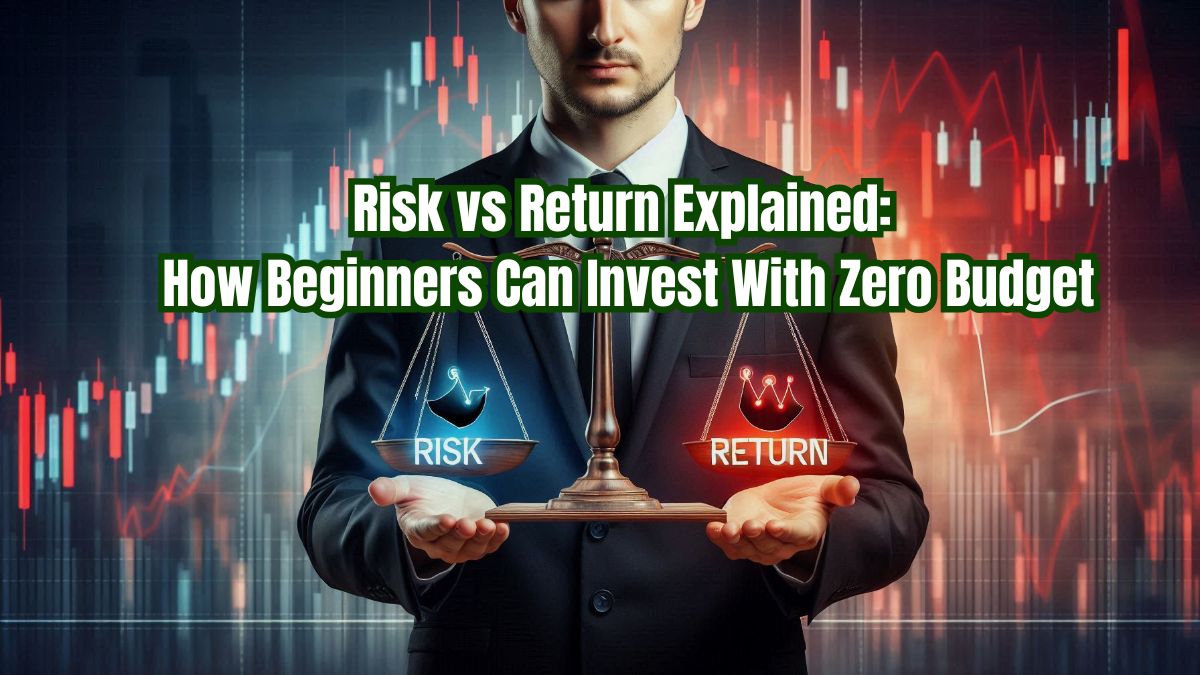Investing can feel like stepping into a maze, especially when you are a beginner with little to no budget. The terms risk and return are often thrown around, but what do they mean? And more importantly, how can you, as a beginner, navigate this relationship to make smart investment decisions, even if you are starting with zero dollars?
In this article, we will explain the basics of risk and return, explore how they are connected, and share actionable tips for investing on a tight budget. By the end, you will clearly understanding of what is the basic relationship between risk and return and how to apply it to your financial journey.
What is the Basic Relationship Between Risk and Return?
At its core, the relationship between risk and return is simple: the higher the potential return, the higher the risk, Conversely, lower-risk investments typically offer lower returns. This principle is the foundation of investing and applies to every type of asset, from stocks, and bonds to real estate and cryptocurrencies.
Let’s break it down further:
Risk: It refers to the possibility of losing some or all of your investment. It’s the uncertainty that comes with putting your money into an asset.
Returns: It is the profit or gains you earn from your investment. It’s the benefit of taking a chance.
For example, investing in a startup company might offer the potential for massive returns if the company succeeds. However, there’s also a high chance you could lose your entire investment if the startup fails. On the other hand, putting your money into a government bond is much safer, but the returns are typically low.
Understanding this relationship is important because it helps you make informed decisions about where to put your money. It’s all about finding the right balance between risk and return that aligns with your financial goals and comfort level.
Types of Risk and Return in Investment
Here are various types of risk and return:
Return
Return on investment can come in various forms:
- Capital Gains: These result from gradual increases in the value of an asset or investment.
- Dividends: Payments made to shareholders from the profits of the company.
- Interest: earning from investments in debt securities such as bonds.
- Rental Income: Earning from real estate investments.
Risk
Here are various types of risks:
Based on Occurrence:
- Pure Risk: This type of risk can either result in no loss or a loss. There is no chance of gain.
- Speculative Risk: This type of risk involves uncertainty and can result in a profit or a loss.
Based on Flexibility:
- Dynamic Risk: It can change the economy and affect many people in different ways.
- Static Risk: Remain constant and don’t change with the economy.
Based on Measurement:
- Financial Risk: It can be measured in money.
- Non-Financial Risk: It cannot be measured in money.
Based on Behaviour:
- Subjective Risk: It is based on an investor’s personal feelings of uncertainty.
- Objective Risk: A precise measure of the risk related to investments.
Based on Coverage:
- Real Risk: This type of risk affects several people or the whole market.
- Particular RIsk: This type of risk affects a specific company or industry.
Based on Diversification:
- Diversified Risk: It can be reduced by spreading investments.
- Non-Diversifed Risk: It cannot be reduced by spreading investments.
There are also other types of risks, such as inflation risk, market risk, interest rate changes, and business risk. These types help us better identify and control risks and returns.
Why Does the Risk-Return Relationship Matter for Beginners?
As a beginner, you might feel tempted to chase high returns without fully understanding the risks involved. This is a common mistake that can lead to significant losses. However, if you are extremely careful about taking risks, you may lose one chance to increase your wealth.
The key is to educate yourself and start small. Even with zero budget, you can begin building your investment knowledge and exploring low-risk opportunities. Over time, as you gain confidence and experience, you can gradually take on more risk for the potential of higher returns.
How to Start Investing with Zero Budget
Yes, you read properly, even if you have no extra money, you can begin investing. Here’s how:
1. Learn on Yourself (The Best Zero-budget Investment)
Take the time to learn the fundamentals of investing before you start. There are countless free resources available online, including blogs, podcasts, YouTube channels, and even free courses on platforms like Coursera and Khan Academy.
Understanding concepts like What is the Basic relationship between risk and return will help you make smarter decisions and avoid costly mistakes.
2. Use Micro-Investing Apps
Micro-investing apps like Stash or Robinhood allow you to start investing with very small amounts of money. Some even let you invest spare change from everyday purchases. While these apps won’t make you rich overnight, they are the best way to dip your toes into the world of investing without needing a large upfront budget.
3. Explore Dividend Reinvestment Plans (DRIPs)
Some companies offer DRIPs, which allow you to buy shares directly from them and reinvest dividends to purchase more shares. This is a low-cost way to start building a portfolio over time.
4. Take Advantage of Free Stock
Several platforms offer free stocks as a sign-up bonus. For example, Robinhood gives users a free stock when they open an account. While the stock might not be worth much, it’s the best way to start investing without spending any money.
5. Invest in Yourself
One of the best investments you can make is in yourself. Learn a new skill, start a side hustle, or build a personal brand. These efforts can generate income that you can later use to fund your investment journey.
Balancing Risk and Return as a Beginner
As a beginner, your primary goal should be to minimize risk while still earning reasonable returns. Here is how to strike that balance:
1. Start with Low-Risk Investment
Focus on low-risk options like high-yield savings accounts, certificates of deposit, or government bonds. These investments won’t make you rich, but they will help you grow your money steadily over time.
2. Diversify Your Portfolio
The process of spreading your investment over multiple asset classes with the goal of lowering risk is known as diversification. For example, instead of putting all your money into stocks, you might invest in a mix of stocks, bonds, and real estate.
3. Avoid Emotional Decision-Making
Market volatility often triggers emotions of fear or greed, leading to impulsive decisions. Staying disciplined and adhering to a well-thought-out investment plan helps mitigate these emotional reactions. Emotional decision-making can derail financial goals, making it crucial to remain calm and focused.
4. Have Clear Goals
Understanding that investing is a long-term game. Don’t expect to get rich overnight. Have clear goals and be patient as your investment grows.
Risk and Return Formula
The relationship between and return is often quantified using financial formulas to help investors make informed decisions. Here are some key formulas that explain this relationship:
1. Expected Return Formula
This formula is the average return an investor can anticipate based on historical data or probabilities. It’s calculated as:

Where,
Ri = Return of the investment in scenario i
Pi = Probability of scenario i occurring
This formula helps investors estimate potential returns while considering the likelihood of different outcomes.
2. Risk (Standard Deviation) Formula
Risk is often measured using standard deviation, which quantifies how much an investment’s returns vary from the average return. The formula is:

A higher standard deviation indicates greater risk, as returns are more volatile.
3. Risk-Adjusted Return (Sharpe Ratio)
The Sharpe Ratio measures how much return an investment generates per unit of risk. It’s calculated as:

A higher Sharpe Ratio indicates better risk-adjusted performance.
4. Capital Asset Pricing Model (CAMP)
CAMP calculated the expected return of an asset based on its systematic risk (beta) and the market risk premium:

CAMP helps investors understand the return they should expect for taking on additional risk.
5. Risk-Return Tradeoff
While not a formula, the risk-return tradeoff is a fundamental principle that can be expressed:

This principle guides investors in balancing their risk tolerance with their return expectations.
These formulas help investors quantify and analyze the relationship between risk and return, enabling them to make data-driven decisions. By understanding these calculations, beginners can better assess investments.
Behavioral Aspects of Risk and Return
Investors’ behavior also affects how risk and return are perceived and managed. Psychological factors such as fear, greed, and herd behavior can lead to irrational investment decisions. Understanding these behavioral biases can help investors make more rational choices aligned with their risk tolerance and financial goals.
Read More: How to Choose a Good Investment?
Final Thoughts
Investing doesn’t have to be expensive. By understanding what is the basic relationship between risk and return, you can make informed decisions that align with your financial goals.
Remember, every expert investor was once a beginner. Start small, focus on learning, and gradually build your portfolio over time. With patience and persistence, you will be well on your way to achieving financial success, even if you are starting with zero budget.
So, what are you waiting for? Take that first step today and begin your investment journey. The future you will thank you!
FAQs: What is the Basic Relationship Between Risk and Return
How can investors manage the relationship between risk and return?
Investors can manage the relationship between risk and return through diversification, which involves spreading investments across different asset classes to reduce risk.
Can you give an example of risk and return?
Yes, consider stocks vs. savings. Investing in stocks has the potential for high returns due to market growth. But it also carries the risk of losses when the market is down. Also, a savings account offers lower returns based on interest but comes with virtually no risk as the principal amount is protected.
What kind of investment is best for beginners?
For beginners, low-risk investments like index funds, ETFs, or high-yield savings accounts are ideal. They are simple, affordable, and offer steady growth.
Can you start investing with a small amount of money?
Yes, you can start investing with just a few dollars using micro-investing apps, fractional shares, or free stock offers. Small steps today can lead to big financial wins tomorrow!
How do you calculate risk and return?
Use expected return for potential gains and standard deviation for risk. Tools like the Sharpe Ratio and CAMP help balance the two and make investing smarter.
What is the risk vs reward balance?
The risk vs reward balance is about weighing potential gains against possible losses. Higher risks can mean bigger rewards, but always align your choices with your goals and comfort level.

Hi everyone, my name is Sharda Kumari, founder of basicfinanceliteracy.com. My love for writing about finance comes from my personal experiences, including investing, saving, and learning from mistakes along the way. I share simple, easy, and honest articles on investing, saving, and financial planning. There is no complex language, no excessive advice, simply useful advice that anybody can follow.
My goal is to make financial literacy feel less like a complicated subject and more like a life skill we all deserve to learn. If you have ever felt lost trying to figure out where to start with money, you are not the only person who thinks like this, and now, you are in the right place.
Thanks for being part of this journey. Let’s grow wiser with money together.
